Abstract
Peripheral blood lymphocytes from 10 nonallergic donors and 7 patients suffering from seasonal allergic rhinitis and receiving desensitization therapy were analyzed by rosette assays for Fc receptors for IgE (Fc epsilon R) and IgG (Fc gamma R) before, during and after the grass pollen season. Six of seven patients had moderately elevated IgE levels (330 +/- 268 IU/ml), all had high titers of skin sensitizing antibodies to grass pollens and serum IgE antibodies as measured by radio-allergosorbent tests (RAST). Seven of the nonallergic donors had 2-30 IU/ml IgE and negative RAST, whereas three had 91-267 IU/ml IgE and two were RAST positive to the grass pollens. In March, when the patients were asymptomatic, the mean +/-SD of the Fc epsilon R+ lymphocytes did not significantly differ from the nonallergic control group: nonallergic Fc epsilon R+ 1.2 +/- 0.9% (29 +/- 20/,mm3), allergic Fc epsilon R+ 2.0 +/- 3.1% (48 +/- 52/mm3). In contrast, during the grass pollen season in May and June, when the patients developed symptoms of allergic rhinitis, they had significantly (P less than 0.01) more Fc epsilon R+ lymphocytes than the controls: nonallergic Fc epsilon R+ 1.7 +/- 1.9% (40 +/- 46/mm3), allergic Fc epsilon R+ 4.7 +/- 1.2% (134 +/- 69/mm3). In the postpollen period, August-October, most of the patients again had low numbers of Fc epsilon R+ lymphocytes: nonallergic Fc epsilon R+ 1.4 +/- 0.9% (26 +/- 13/mm3), allergic Fc epsilon R+ 2.1 +/- 1.9% (62 +/- 82/mm3). The nonallergic control donors with elevated IgE levels and positive RAST always had low numbers of Fc epsilon R+ lymphocytes. In contrast, two other nonallergic donors, who had a 2-7 IU/ml IgE and negative RAST, showed significant increases of Fc epsilon R+ lymphocytes over several weeks during the grass pollen season. No statistically significant changes in Fc gamma R+ lymphocytes occurred in both nonallergic and allergic donors. The total and specific IgE serum levels did not vary much in the nonallergic donors and patients during the period of study and any changes that did occur did not correlate with the changes in Fc epsilon R+ lymphocytes. The data demonstrate that Fc epsilon R+ peripheral blood lymphocytes increase in allergic patients during natural antigen exposure and active disease in the absence of measurable increases of total and specific serum IgE. Because two nonallergic control donors also had temporary increases of Fc epsilon R+ lymphocytes, an increase of peripheral blood Fc epsilon R+ lymphocytes may be a sensitive indicator of an ongoing IgE immune response.
Full text
PDF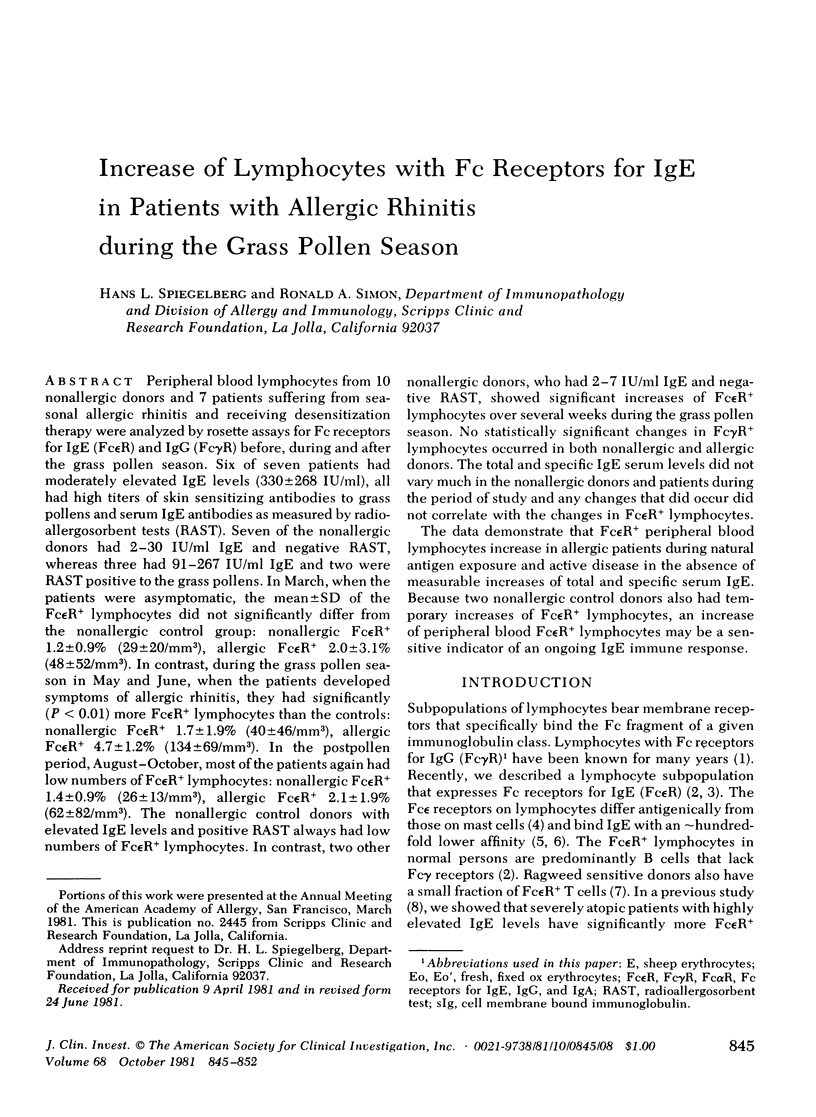
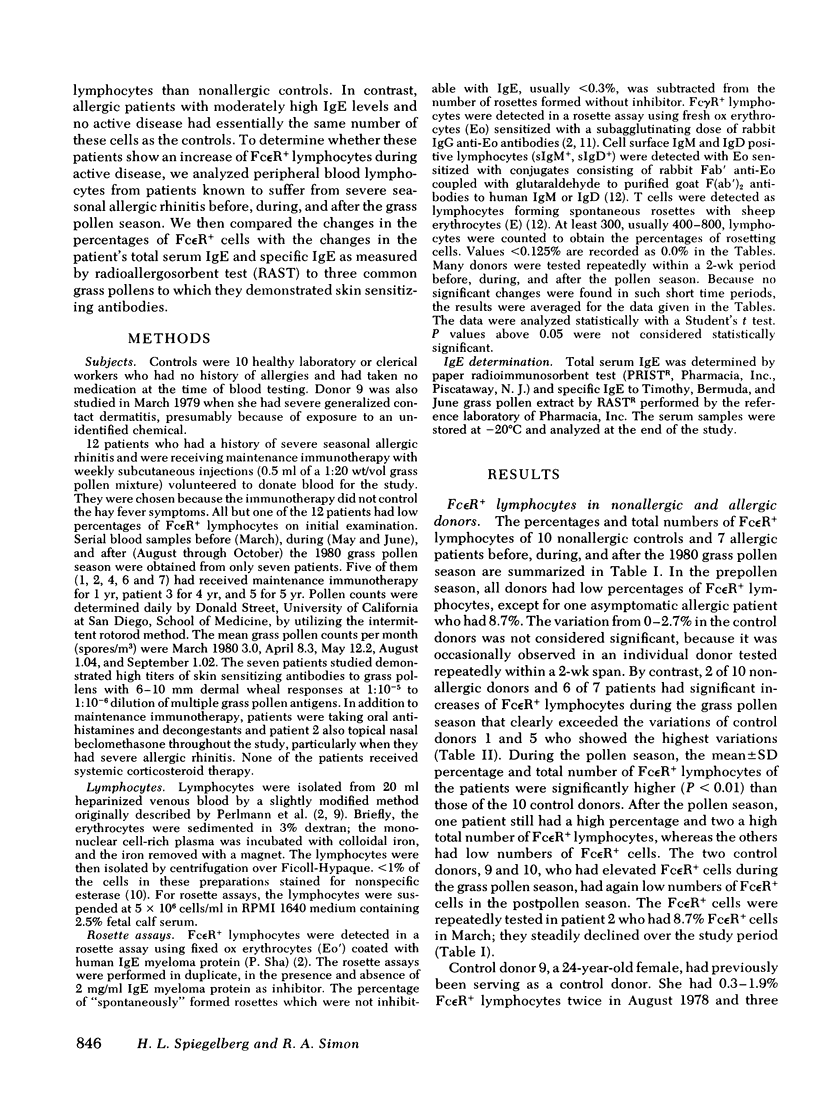
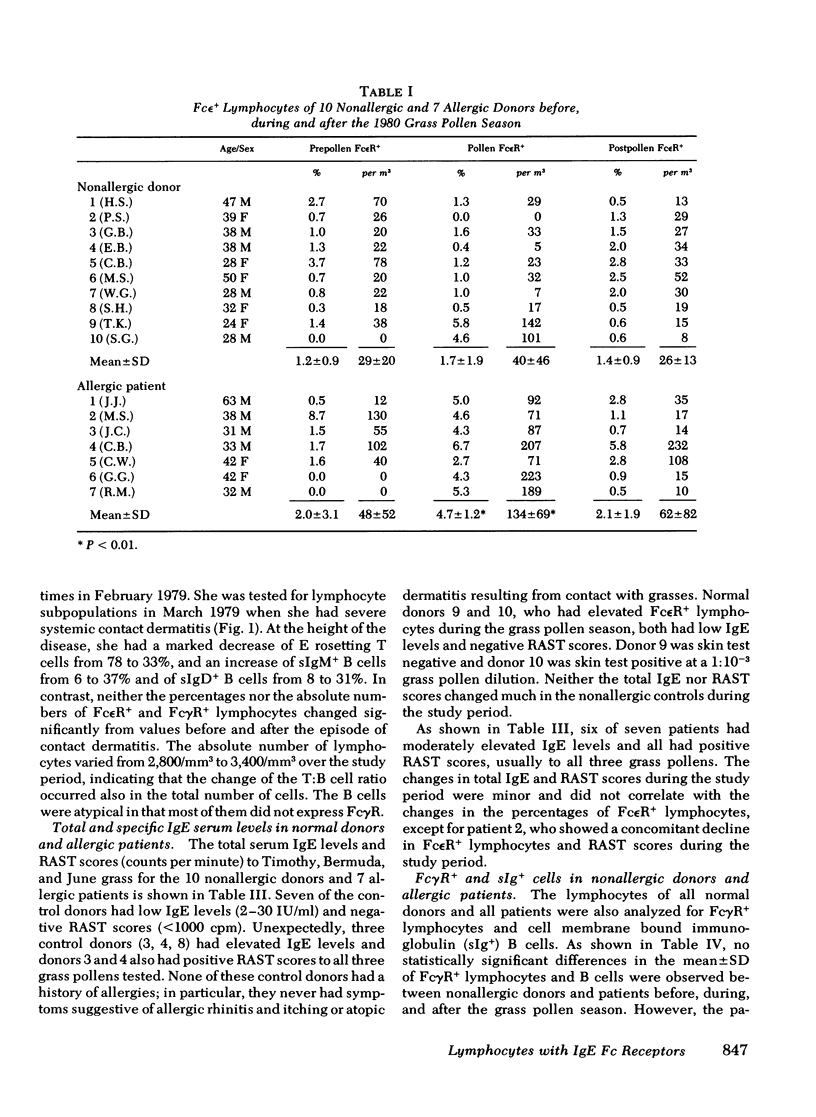
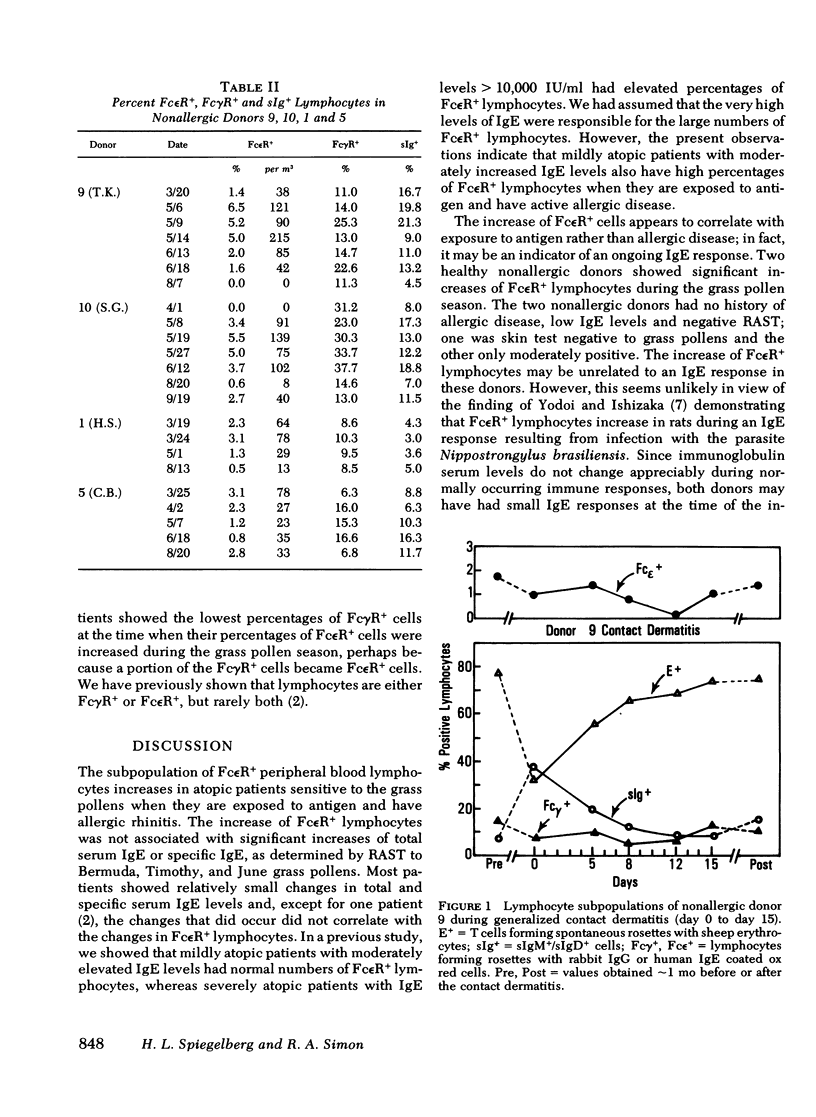
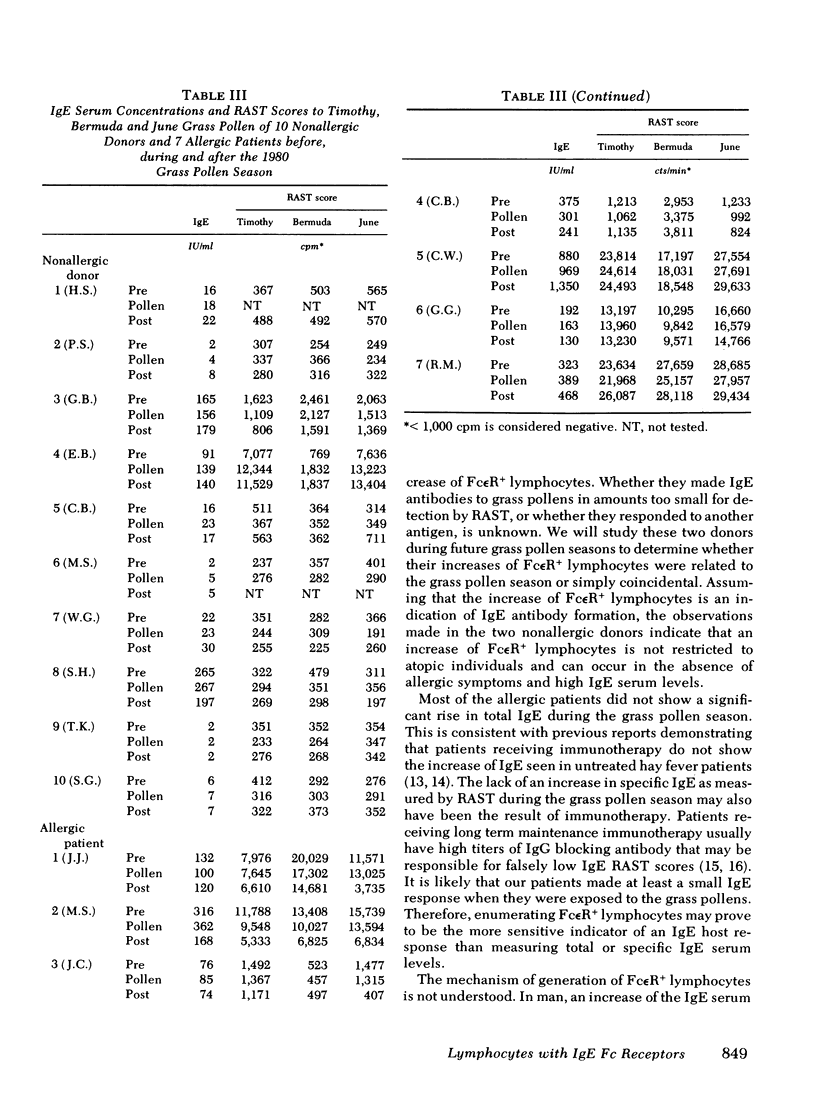
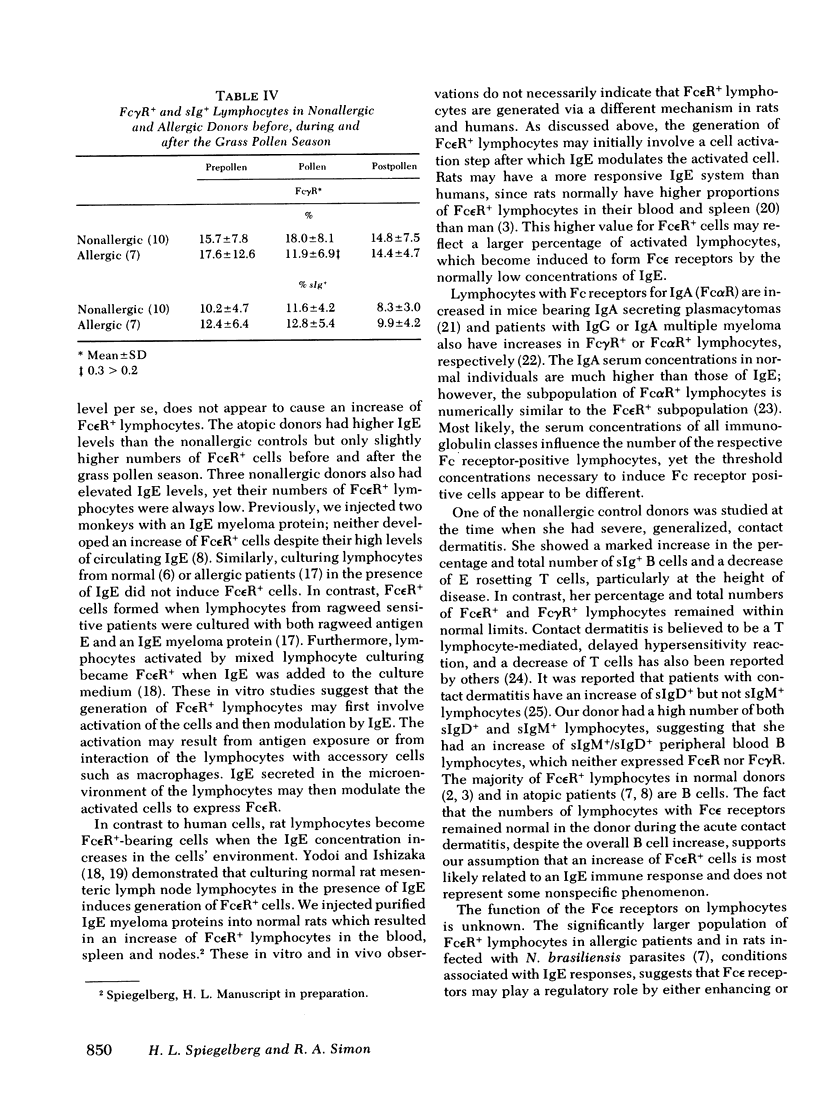

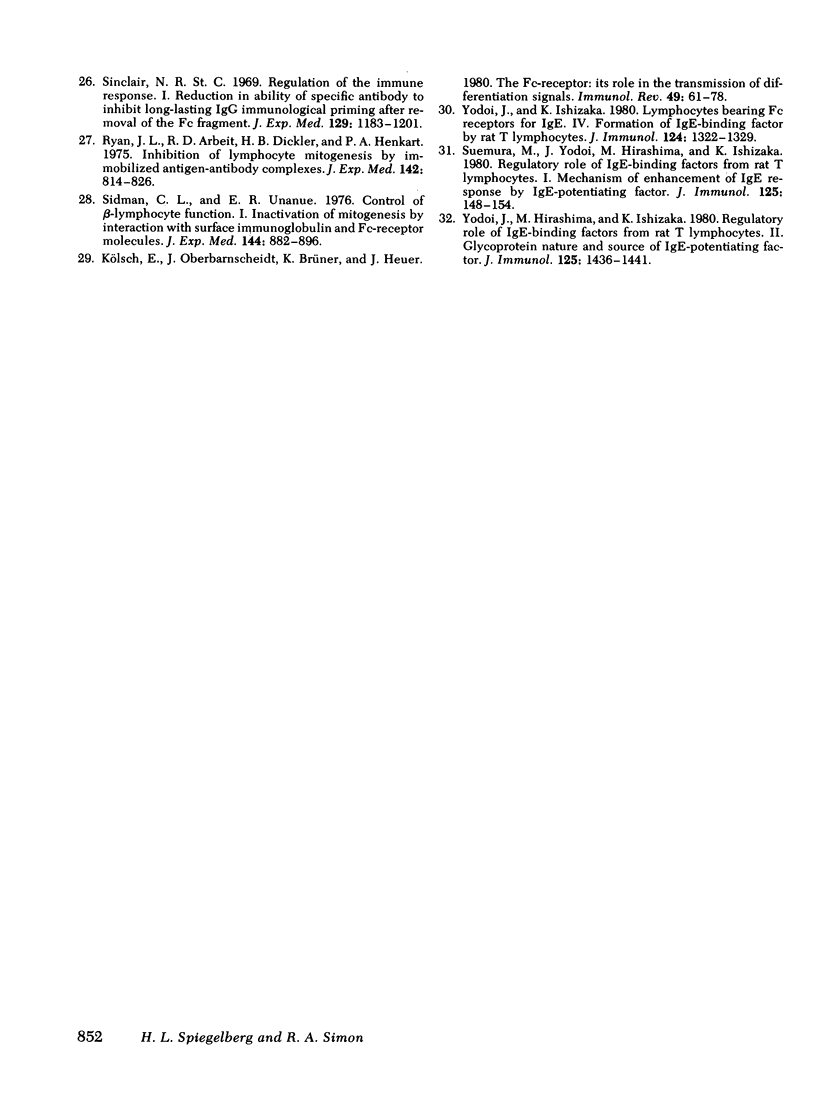
Selected References
These references are in PubMed. This may not be the complete list of references from this article.
- Carapeto F. J., Winkelmann R. K., Jordon R. E. T and B lymphocytes in contact and atopic dermatitis. Arch Dermatol. 1976 Aug;112(8):1095–1100. [PubMed] [Google Scholar]
- Cormane R. H., Husz S., Hamerlinck F. Immunoglobulin- and complement-bearing lymphocytes in allergic contact dermatitis and atopic dermatitis (eczema). Br J Dermatol. 1974 Jun;90(6):597–605. doi: 10.1111/j.1365-2133.1974.tb06687.x. [DOI] [PubMed] [Google Scholar]
- Dickler H. B. Lymphocyte receptors for immunoglobulin. Adv Immunol. 1976;24:167–214. doi: 10.1016/s0065-2776(08)60330-2. [DOI] [PubMed] [Google Scholar]
- Fritsche R., Spiegelberg H. L. Fc receptors for IgE on normal rat lymphocytes. J Immunol. 1978 Aug;121(2):471–478. [PubMed] [Google Scholar]
- Gleich G. J., Jacob G. L., Yunginger J. W., Henderson L. L. Measurement of the absolute levels of IgE antibodies in patients with ragweed hay fever. J Allergy Clin Immunol. 1977 Sep;60(3):188–198. doi: 10.1016/0091-6749(77)90123-3. [DOI] [PubMed] [Google Scholar]
- Gonzalez-Molina A., Spiegelberg H. L. A subpopulation of normal human peripheral B lymphcytes that bind IgE. J Clin Invest. 1977 Apr;59(4):616–624. doi: 10.1172/JCI108679. [DOI] [PMC free article] [PubMed] [Google Scholar]
- Hallberg T., Gurner B. W., Coombs R. R. Opsonic adherence of sensitized ox red cells to human lymphocytes as measured by rosette formation. Int Arch Allergy Appl Immunol. 1973;44(4):500–513. doi: 10.1159/000230956. [DOI] [PubMed] [Google Scholar]
- Hellström U., Spiegelberg H. L. Characterization of human lymphocytes bearing Fc receptors for IgE isolated from blood and lymphoid organs. Scand J Immunol. 1979;9(1):75–86. doi: 10.1111/j.1365-3083.1979.tb02709.x. [DOI] [PubMed] [Google Scholar]
- Hoover R. G., Hickman S., Gebel H. M., Rebbe N., Lynch R. G. Expansion of Fc receptor-bearing T lymphocytes in patients with immunoglobulin G and immunoglobulin A myeloma. J Clin Invest. 1981 Jan;67(1):308–311. doi: 10.1172/JCI110028. [DOI] [PMC free article] [PubMed] [Google Scholar]
- Hoover R. G., Lynch R. G. Lymphocyte surface membrane immunoglobulin in myeloma. II. T cells with IgA-Fc receptors are markedly increased in mice with IgA plasmacytomas. J Immunol. 1980 Sep;125(3):1280–1288. [PubMed] [Google Scholar]
- Horwitz D. A., Allison A. C., Ward P., Kight N. Identification of human mononuclear leucocyte populations by esterase staining. Clin Exp Immunol. 1977 Nov;30(2):289–298. [PMC free article] [PubMed] [Google Scholar]
- Kölsch E., Oberbarnscheidt J., Brüner K., Heuer J. The Fc-receptor: its role in the transmission of differentiation signals. Immunol Rev. 1980;49:61–78. doi: 10.1111/j.1600-065x.1980.tb00426.x. [DOI] [PubMed] [Google Scholar]
- Levy D. A., Lichtenstein L. M., Goldstein E. O., Ishizaka K. Immunologic and cellular changes accompanying the therapy of pollen allergy. J Clin Invest. 1971 Feb;50(2):360–369. doi: 10.1172/JCI106503. [DOI] [PMC free article] [PubMed] [Google Scholar]
- Lum L. G., Muchmore A. V., O'Connor N., Strober W., Blaese R. M. Fc receptors for IgA on human B, and human non-B, non-T lymphocytes. J Immunol. 1979 Aug;123(2):714–719. [PubMed] [Google Scholar]
- Meinke G. C., Magro A. M., Lawrence D. A., Spiegelberg H. L. Characterization of an IgE receptor isolated from cultured B-type lymphoblastoid cells. J Immunol. 1978 Oct;121(4):1321–1328. [PubMed] [Google Scholar]
- Nicholas R., Sinclair S. C. Regulation of the immune response. I. Reduction in ability of specific antibody to inhibit long-lasting IgG immunological priming after removal of the Fc fragment. J Exp Med. 1969 Jun 1;129(6):1183–1201. doi: 10.1084/jem.129.6.1183. [DOI] [PMC free article] [PubMed] [Google Scholar]
- Perlmann H., Perlmann P., Pape G. R., Halldén G. Purification, fractionation and assay of antibody-dependent lymphocytic effector cells (K cells) in human blood. Scand J Immunol. 1976 Jun;Suppl 5:57–68. doi: 10.1111/j.1365-3083.1976.tb03856.x. [DOI] [PubMed] [Google Scholar]
- Ryan J. L., Arbeit R. D., Dickler H. B., Henkart P. A. Inhibition of lymphocyte mitogenesis by immobilized antigen-antibody complexes. J Exp Med. 1975 Oct 1;142(4):814–826. doi: 10.1084/jem.142.4.814. [DOI] [PMC free article] [PubMed] [Google Scholar]
- Sidman C. L., Unanue E. R. Control of B-lymphocyte function. I. Inactivation of mitogenesis by interactions with surface immunoglobulin and Fc-receptor molecules. J Exp Med. 1976 Oct 1;144(4):882–896. doi: 10.1084/jem.144.4.882. [DOI] [PMC free article] [PubMed] [Google Scholar]
- Spiegelberg H. L., Dainer P. M. Fc receptors for IgG, IgM and IgE on human leukaemic lymphocytes. Clin Exp Immunol. 1979 Feb;35(2):286–295. [PMC free article] [PubMed] [Google Scholar]
- Spiegelberg H. L., Melewicz F. M. Fc receptors specific for IgE on subpopulations of human lymphocytes and monocytes. Clin Immunol Immunopathol. 1980 Mar;15(3):424–433. doi: 10.1016/0090-1229(80)90054-9. [DOI] [PubMed] [Google Scholar]
- Spiegelberg H. L., O'Connor R. D., Simon R. A., Mathison D. A. Lymphocytes with immunoglobulin E Fc receptors in patients with atopic disorders. J Clin Invest. 1979 Sep;64(3):714–720. doi: 10.1172/JCI109514. [DOI] [PMC free article] [PubMed] [Google Scholar]
- Suemura M., Yodoi J., Hirashima M., Ishizaka K. Regulatory role of IgE-binding factors from rat T lymphocytes. I. Mechanism of enhancement of IgE response by IgE-potentiating factor. J Immunol. 1980 Jul;125(1):148–154. [PubMed] [Google Scholar]
- Yodoi J., Hirashima M., Ishizaka K. Regulatory role of IgE-binding factors from rat T lymphocytes. II. Glycoprotein nature and source of IgE-potentiating factor. J Immunol. 1980 Oct;125(4):1436–1441. [PubMed] [Google Scholar]
- Yodoi J., Ishizaka K. Induction of Fc epsilon-receptor bearing cells in vitro in human peripheral lymphocytes. J Immunol. 1980 Feb;124(2):934–938. [PubMed] [Google Scholar]
- Yodoi J., Ishizaka K. Lymphocytes bearing Fc receptors for IgE. I. Presence of human and rat T lymphocytes with Fc epsilon receptors. J Immunol. 1979 Jun;122(6):2577–2583. [PubMed] [Google Scholar]
- Yodoi J., Ishizaka K. Lymphocytes bearing Fc receptors for IgE. IV. Formation of IgE-binding factor by rat T lymphocytes. J Immunol. 1980 Mar;124(3):1322–1329. [PubMed] [Google Scholar]
- Yodoi J., Ishizaka K. Lymphocytes bearing receptors for IgE. III. Transition of Fc gamma R(+) cells to Fc epsilon R(4) cells by IgE. J Immunol. 1979 Nov;123(5):2004–2010. [PubMed] [Google Scholar]
- Yodoi J., Ishizaka T., Ishizaka K. Lymphocytes bearing Fc receptors for IgE. II. Induction of Fcepsilon-receptor bearing rat lymphocytes by IgE. J Immunol. 1979 Jul;123(1):455–462. [PubMed] [Google Scholar]
- Zeiss C. R., Grammer L. C., Levitz D. Comparison of the radioallergosorbent test and a quantitative solid-phase radioimmunoassay for the detection of ragweed-specific immunoglobulin E antibody in patients undergoing immunotherapy. J Allergy Clin Immunol. 1981 Feb;67(2):105–110. doi: 10.1016/0091-6749(81)90004-x. [DOI] [PubMed] [Google Scholar]
- Zimmermann E. M., Yunginger J. W., Gleich G. J. Interference in ragweed pollen and honeybee venom radioallergosorbent tests. J Allergy Clin Immunol. 1980 Nov;66(5):386–393. doi: 10.1016/0091-6749(80)90118-9. [DOI] [PubMed] [Google Scholar]


